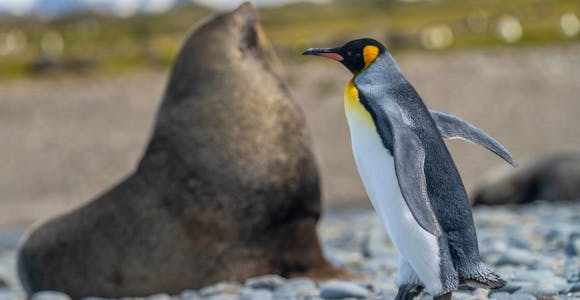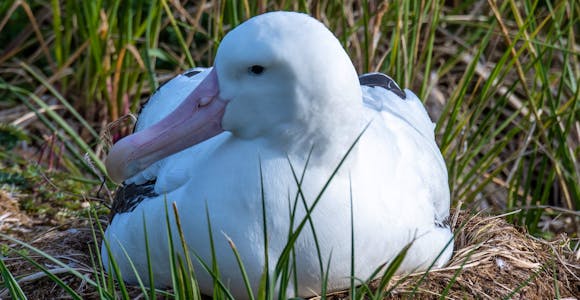
Salisbury Plain
With its amphitheatre-like mountains and large numbers of king penguins and elephant and fur seals, Salisbury Plain is as truly jaw-dropping as South Georgia gets.
Discover More
Ship cruising at Shag Rocks
Shag Rocks consists of six rocky islets rising sharply from the Southern Ocean. They are the westernmost outpost of the British Overseas Territory of South Georgia and the South Sandwich Islands, and when spotted on the second day of the voyage from the Falkland Islands, an important waypoint that lets you know that you're getting close to South Georgia. It is likely that they were first spotted in 1762 by Joseph de Llana in the Aurora, but they were definitively put on the map by the American sealer James Sheffield in 1819/20 during his voyage to the South Shetland Islands.
The jagged rocks are the tip of an ancient seamount on the undersea Scotia Ridge and are made of metamorphic green schist around 150 million years old, making them considerably older than the mainland of South Georgia. Their white hue today is derived from the guano of the thousands of imperial cormorants (also known as blue-eyed shags) that nest on its cliffs.
Upwellings and currents around the rocks make the seas here rich in krill, toothfish and icefish, which make this a particularly lively feeding spot for seabirds and whales. It is also an important fishery: Shag Rocks lies within South Georgia's Marine Protected Area and fish and krill stocks are tightly monitored.

Imperial cormorant in flight
The dominant species spotted around Shag Rocks is the imperial cormorant (blue-eyed shag), which give the rocks their name. They are the only species that nest on the rocks, but the area attracts large numbers of petrels and prions. In the sea, it's not uncommon to see rafts of penguins (mostly usually gentoos) around the rocks – an amazing demonstration of just how far from land these birds will range for food.
The nutrient-rich waters are also very attractive to whales. If you visit later in the austral summer, there is a reasonable chance of seeing humpback and fin whales in the area; on several occasions since 2020 super-aggregations of more than 100 feeding humpbacks have been seen here, though you would have to be very lucky to encounter one.
Price Match Promise - We’ll match any price you find elsewhere for the same trip
Ship cruises are the order of the day at Shag Rocks, where the open ocean makes even zodiac cruising a dangerous prospect. There's not a scrap of flat land to be had – the first 'landing' was made here in 1956 when an Argentinian geologist was lowered by helicopter to take samples.
If you're lucky enough to see whales here, the ship's captain may stop the vessel for a viewing, but otherwise sighting the rocks is enough to know that South Georgia is on the horizon – you won't want to slow down too much!

With its amphitheatre-like mountains and large numbers of king penguins and elephant and fur seals, Salisbury Plain is as truly jaw-dropping as South Georgia gets.
Discover More
Prion Island is the only place on South Georgia where at certain times of the year you can observe wandering albatrosses on their nests.
Discover More
Right Whale Bay is home to a large king penguin colony that stretches up the hill from the beach, and immense numbers of fur seals.
Discover More
This landing site is a good place for king penguins, elephant seals and fur seals and has a sheltered lagoon that's perfect for kayaking.
Discover MoreWe'll spend some time listening to your aspirations, then discuss the kind of experience that might suit you.
Next we'll discuss the options, shortlist the best trips for you and present you our impartial recommendations.
We'll place a 24 hour hold on your preferred option - without obligation - whilst we talk through the details.
With over 100 years of South Georgia experience between us, we can help you to exactly the right trip for you.
1 888 970 4570